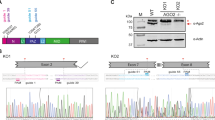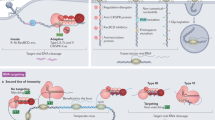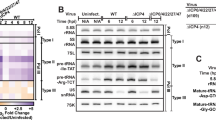Key Points
-
RNA interference (RNAi) is the process by which double-stranded RNA (dsRNA) induces silencing of homologous, endogenous and exogenous genes. This offers a powerful process to regulate gene expression to determine the role of specific proteins in biological processes.
-
The replication of viruses, such as HIV-1, depends on cellular factors that can oppose or enhance virus replication. RNAi can be used to manipulate the expression of these cellular factors to examine their role in virus replication.
-
Several strategies are being developed to introduce interfering RNAs into cells that are normally infected by viruses, so facilitating the study of HIV biology by RNAi.
-
The use of RNAi as a therapeutic approach to virus infections such as AIDS faces several obstacles. However, because of its mechanism of action, RNAi-based therapeutic approaches might prove effective where other antiviral agents in use at present have failed.
Abstract
In cells of organisms, ranging from nematodes to primates, there is a process known as RNA interference (RNAi) that effects the degradation of RNA in a highly sequence-specific manner. Scientists have figured out a way to co-opt elements of the RNAi machinery such that almost any RNA can be targeted for degradation. It is now clear that HIV-1 is fair game for RNAi; viral RNA intermediates have been targeted as well as messenger RNAs for cellular co-factors that are required for replication of HIV-1. The hope is that RNAi can be used not only as a research tool, but also as a therapeutic strategy for infection with HIV-1.
This is a preview of subscription content, access via your institution
Access options
Subscribe to this journal
Receive 12 print issues and online access
$209.00 per year
only $17.42 per issue
Buy this article
- Purchase on Springer Link
- Instant access to full article PDF
Prices may be subject to local taxes which are calculated during checkout




Similar content being viewed by others
References
Napoli, C., Lemieux, C. & Jorgensen, R. Introduction of a chimeric chalcone synthse gene into Petunia results in reversible co-suppression of homologous genes in trans. Plant Cell. 2, 279–289 (1990).
Lindbo, J. & Dougherty, W. Untranslatable transcripts of the tobacco etch virus coat protein gene sequence can interfere with tobacco etch virus replication in transgenic plants and protoplasts. Virology 189, 725–733 (1992).
Dougherty, W. et al. RNA-mediated virus resistance in transgenic plants: exploitation of a cellular pathway possibly involved in RNA degradation. Mol. Plant Microbe Interact. 7, 544–552 (1994).
Angell, S. & Baulcombe, D. Consistent gene silencing in transgenic plants expressing a replicating potato virus X RNA. EMBO J. 16, 3675–3684 (1997).
Guo, S. & Kemphues, K. par-1, a gene required for establishing polarity in C. elegans embryos, encodes a putative Ser/Thr kinase that is asymmetrically distributed. Cell 81, 611–620 (1995).
Fire, A. et al. Potent and specific genetic interference by double-stranded RNA in Caenorhabditis elegans. Nature 391, 806–811 (1998). The first to show that double-stranded RNA (dsRNA) promotes the sequence-specific destruction of endogenous RNAs.
Bernstein, E., Denli, A. & Hannon, G. The rest is silence. RNA 7, 1509–1521 (2001).
Hamilton, A. & Baulcombe, D. A species of small antisense RNA in posttranscriptional gene silencing in plants. Science 286, 950–952 (1999). The first evidence that small ∼25-nucleotide RNAs might be the mediators of post-transcriptional gene silencing mediated by dsRNA.
Kennerdell, J. & Carthew, R. Use of dsRNA-mediated genetic interference to demonstrate that frizzled and frizzled 2 act in the wingless pathway. Cell 95, 1017–1026 (1998).
Tuschl, T., Zamore, P. D., Lehmann, R., Bartel, D. & Sharp, P. Targeted mRNA degradation by double-stranded RNA in vitro. Genes Dev. 15, 3191–3197 (1999). The first to describe that long dsRNA is processed to ∼22-nucleotide guide RNAs. This study also showed that messenger RNAs are cleaved at regular intervals in response to dsRNA.
Hammond, S., Bernstein, E., Beach, D. & Hannon, G. An RNA-directed nuclease mediates post-transcriptional gene silencing in Drosophila cells. Nature 404, 293–296 (2000). Identification of a nuclease activity that targets mRNAs for degradation.
Elbashir, S. et al. Duplexes of 21-nucleotide RNAs mediate RNA interference in cultured mammalian cells. Nature 411, 494–498 (2001). The authors showed that synthetic 21-nucleotide RNA duplexes activate RNA interference (RNAi) in mammalian cell systems.
Zamore, P. D., Tuschl, T., Sharp, P. & Bartel, D. RNAi: double-stranded RNA directs the ATP-dependent cleavage of mRNA at 21 to 23 nucleotide intervals. Cell 101, 25–33 (2000).
Paddison, P. J., Caudy, A. A. & Hannon, G. J. Stable suppression of gene expression by RNAi in mammalian cells. Proc. Natl Acad. Sci. USA 99, 1443–1448 (2002).
Billy, E., Brondani, V., Zhang, H., Muller, U. & Rilipowicz, W. Specific interference with gene expression induced by long, double-stranded RNA in mouse embryonal teratocarcinoma cell lines. Proc. Natl Acad. Sci. USA 98, 14428–14433 (2001).
Stark, G., Kerr, I., Williams, B., Silverman, R. & Schrieber, R. How cells respond to interferons. Annu. Rev. Biochem. 67, 227–264 (1998).
Sledz, C. A., Holko, M., De Veer, M. J., Silverman, R. H. & Williams, B. R. Activation of the interferon system by short-interfering RNAs. Nature Cell Biol. 5, 834–839 (2003). This paper shows that activation of dsRNA-dependent protein kinase (PKR) is mediated not only by long dsRNA, but also by small interfering (siRNAs).
Lee, N. et al. Expression of small interfering RNAs targeted against HIV-1 rev transcripts in human cells. Nature Biotechnol. 20, 500–505 (2002).
Novina, C. et al. siRNA-directed inhibition of HIV-1 infection. Nature Med. 8, 681–686 (2002).
Jacque, J. -M., Triques, K. & Stevenson, M. Modulation of HIV-1 replication by RNAi. Nature 418, 435–438 (2002).
Coburn, G. & Cullen, B. R. Potent and specific inhibition of human immunodeficiency virus type 1 replication by RNA interference. J. Virol. 76, 9225–9231 (2002).
Capodici, J., Kariko, K. & Weissman, D. Inhibition of HIV-1 infection by small interfering RNA-mediated RNA interference. J. Immunol. 169, 5196–5201 (2002).
Park, W. et al. Prevention of HIV-1 infection in human peripheral blood mononuclear cells by specific RNA interference. Nucleic Acids Res. 30, 4830–4835 (2002).
Surabhi, R. & Gaynor, R. RNA interference directed against viral and cellular targets inhibits human immunodeficiency virus type 1 replication. J. Virol. 76, 12963–12973 (2002).
Yamamoto, T. et al. Double-stranded nef RNA interferes with human immunodeficiency virus type 1 replication. Microbiol. Immunol. 46, 809–817 (2002).
Hu, W., Myers, C., Kilzer, J., Pfaff, S. & Bushman, F. Inhibition of retroviral pathogenesis by RNA interference. Curr. Biol. 12, 1301–1311 (2002).
Song, E. et al. Sustained small interfering RNA-mediated human immunodeficiency virus type 1 inhibition in primary macrophages. J. Virol. 77, 7174–7181 (2003).
Zeng, Y. & Cullen, B. R. RNA interference in human cells is restricted to the cytoplasm. RNA 8, 855–860 (2002).
Bitko, V. & Barik, S. Phenotypic silencing of cytoplasmic genes using sequence-specific double-stranded short interfering RNA and its application in the reverse genetics of wild type negative-strand RNA viruses. BMC Microbiol. 1, 34 (2001).
Vickers, T. et al. Efficient reduction of target RNAs by small interfering RNA and RNase H-dependent antisense agents. A comparative analysis. J. Biol. Chem. 279, 7108–7118 (2003).
Qin, X., An, D., Chen, I. & Baltimore, D. Inhibiting HIV-1 infection in human T cells by lentiviral-mediated delivery of small interfering RNA against CCR5. Proc. Natl Acad. Sci. USA 100, 183–188 (2003).
Martinez, M. et al. Suppression of chemokine receptor expression by RNA interference allows for inhibition of HIV-1 replication. AIDS 16, 2385–2390 (2002).
Garrus, J. E. et al. Tsg101 and the vacuolar protein sorting pathway are essential for HIV-1 budding. Cell 107, 55–65 (2001). The first study to use RNAi to validate a role for a cellular co-factor in HIV-1 replication.
O'Brien, S. & Moore, J. The effect of genetic variation in chemokines and their receptors in HIV transmission and progression to AIDS. Immunol. Rev. 177, 99–111 (2000).
Moore, J. & Stevenson, M. New targets for inhibitors of HIV-1 replication. Nature Rev. Mol. Cell Biol. 1, 40–49 (2000).
Holen, T., Amarzguioui, M., Wiiger, M., Babaie, E. & Prydz, H. Positional effects of short interfering RNAs targeting the human coagulation trigger tissue factor. Nucleic Acids Res. 30, 1757–1766 (2002).
Song, E. et al. RNA interference targeting Fas protects mice from fulminant hepatitis. Nature Med. 9, 347–351 (2003).
McCaffrey, A. et al. RNA interference in adult mice. Nature 418, 38–39 (2002).
Lewis, D., Hagstrom, J., Loomis, A., Wolff, J. & Herweijer, H. Efficient delivery of siRNA for inhibition of gene expression in postnatal mice. Nature Genet. 32, 107–108 (2002).
Dykxhoorn, D., Novina, C. & Sharp, P. Killing the messenger: short RNAs that silence gene expression. Nature Rev. Mol. Cell Biol. 4, 457–467 (2003).
Weinberg, J. B., Matthews, T. J., Cullen, B. R. & Malim, M. H. Productive human immunodeficiency virus type 1 (HIV-1) infection of nonproliferating human monocytes. J. Exp. Med. 174, 1477–1482 (1991).
Bukrinsky, M. I. et al. Active nuclear import of human immunodeficiency virus type 1 preintegration complexes. Proc. Natl Acad. Sci. USA 89, 6580–6584 (1992).
Naldini, L. et al. In vivo gene delivery and stable transduction of nondividing cells by a lentiviral vector. Science 272, 263–267 (1996).
Xia, H., Mao, Q., Paulson, H. & Davidson, B. siRNA-mediated gene silencing in vitro and in vivo. Nature Biotechnol. 20, 1006–1010 (2002).
Rubinson, D. et al. A lentivirus-bassed system to functionally silence genes in primary mammalian cells, stem cells, and transgenic mice by RNA interference. Nature Genet. 33, 401–406 (2003).
Stewart, S. et al. Lentivirus-delivered stable gene silencing by RNAi in primary cells. RNA 9, 493–501 (2003).
Tiscornia, G., Singer, O., Ikawa, M. & Verma, I. M. A general method for gene knockdown in mice by using lentiviral vectors expressing small interfering RNA. Proc. Natl Acad. Sci. USA 100, 1844–1848 (2003).
Walker, B. D. & Korber, B. Immune control of HIV: the obstacles of HLA and viral density. Nature Immunol. 2, 473–475 (2001).
Gitlin, L., Karelsky, S. & Andino, R. Short interfering RNA confers intracellular antiviral immunity in human cells. Nature 25, 430–434 (2002). A paper showing that siRNA-resistant escape mutants of poliovirus emerge rapidly in culture.
McManus, M. et al. Small interfering RNA-mediated gene silencing in T lymphocytes. J. Immunol. 15, 5754–5760 (2002).
Orenstein, J. M., Meltzer, M. S., Phipps, T. & Gendelman, H. E. Cytoplasmic assembly and accumulation of human immunodeficiency virus types 1 and 2 in recombinant human colony-stimulating factor-1-treated human monocytes: an ultrastructural study. J. Virol. 62, 2578–2586 (1988).
Raposo, G. et al. Human macrophages accumulate HIV-1 particles in MHC II compartments. Traffic 3, 718–729 (2002).
Geijtenbeek, T. et al. DC-SIGN, a dendritic cell-specific HIV-1-binding protein that enhances trans-infection of T cells. Cell 100, 587–597 (2000).
Kwon, D., Gregorio, G., Bitton, N., Hendrickson, W. & Littman, D. DC-SIGN-mediated internalization of HIV is required for trans-enhancement of T cell infection. Immunity 16, 135–144 (2002).
Smith, B. et al. Persistence of infectious HIV on follicular dendritic cells. J. Immunol. 1, 690–696 (2001).
Palauqui, J., Elmayan, T., Pollien, J. & Vaucheret, H. Systematic acquired silencing: transgene-specific post-transitional silencing is transmitted by grafting from silenced stocks to non-silenced scions. EMBO J 1, 4738–4745 (1997).
Winston, W., Molodowitch, C. & Hunter, C. Systemic RNAi in C. elegans requires the putative transmembrane proteins SID-1. Science 29, 2456–2459 (2002).
Cogoni, C. & Macino, G. Gene silencing in Neurospora crassa requires a protein homologous to RNA-dependent RNA polymerase. Nature 399, 166–169 (1999).
Dalmay, T., Hamilton, A., Rudd, S., Angell, S. & Baulcombe, D. An RNA-dependent RNA polymerase gene in Arabiopsis is required for posttranscriptional gene silencing mediated by a trangene but not by a virus. Cell 101, 543–553 (2000).
Lipardi, C., Wei, Q. & Paterson, B. M. RNAi as random degradative PCR: siRNA primers convert mRNA into dsRNAs that are degraded to generate new siRNAs. Cell 107, 297–307 (2001).
Sijen, T. et al. On the role of RNA amplification in dsRNA-triggered gene silencing. Cell 107, 465–476 (2001).
Stein, P., Svoboda, P., Anger, M. & Schultz, R. M. RNAi: mammalian oocytes do it without RNA-dependent RNA polymerase. RNA 9, 187–192 (2003).
Cullen, B. R. RNA interference: antiviral defense and genetic tool. Nature Immunol. 3, 597–595 (2002).
Paddison, P. J., Caudy, A. A., Bernstein, E., Hannon, G. J. & Conklin, D. S. Short hairpin RNAs (shRNAs) induce sequence-specific silencing in mammalian cells. Genes Dev. 16, 948–958 (2002).
Brummelkamp, T. R., Bernards, R. & Agami, R. Stable suppression of tumorigenicity by virus-mediated RNA interference. Cancer Cell 2, 243–247 (2002).
Miyagishi, M. & Taira, K. U6 promoter–driven siRNAs with four uridine 3′ overhangs efficiently suppress targeted gene expression in mammalian cells. Nature Biotechnol. 20, 497–500 (2002).
Author information
Authors and Affiliations
Glossary
- GENOMIC VIRAL RNA
-
A viral RNA intermediate that is packaged in virus particles and that is converted into a complemetary DNA after introduction into the target cell.
- PROVIRUS
-
A retroviral complementary DNA that is integrated in the chromosomal DNA of the host cell.
- NUCLEOCYTOPLASMIC SHUTTLING
-
The process by which macromolecules, either of host or of exogenous (for example, virus) origin, move between the nucleus and cytoplasm.
- FOLLICULAR DENDRITIC CELLS
-
Cells in the lymph node that present antigens within immune complexes to B cells.
Rights and permissions
About this article
Cite this article
Stevenson, M. Dissecting HIV-1 through RNA interference. Nat Rev Immunol 3, 851–858 (2003). https://doi.org/10.1038/nri1227
Issue Date:
DOI: https://doi.org/10.1038/nri1227
This article is cited by
-
Dual MicroRNA to Cellular Prion Protein Inhibits Propagation of Pathogenic Prion Protein in Cultured Cells
Molecular Neurobiology (2018)
-
Cell Penetration and Secondary Structure of a Synthetic Peptide with Anti-HIV Activity
International Journal of Peptide Research and Therapeutics (2017)
-
Long-term inhibition of hepatitis B virus in transgenic mice by double-stranded adeno-associated virus 8-delivered short hairpin RNA
Gene Therapy (2007)
-
siRNA therapeutics: big potential from small RNAs
Gene Therapy (2005)
-
siRNAs: applications in functional genomics and potential as therapeutics
Nature Reviews Drug Discovery (2004)



